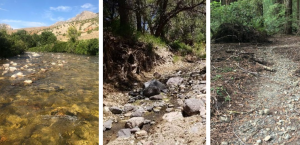Tools being finalized to help determine whether streams subject to Clean Water Act

perennial, intermittent or ephemeral stream flows. From left to right, Shell Creek in Wyoming is
classified as having perennial flows, Truxton Wash in Arizona as having intermittent flows, and Calf
Creek in California as having ephemeral stream flows.
The U.S. Environmental Protection Agency and the U.S. Army Corps of Engineers are preparing to release final versions of flow classification tools intended to help watershed managers determine which streams the federal government has jurisdiction to regulate under the Clean Water Act – the culmination of a sweeping, five-year national research initiative co-led by SCCWRP.
The Streamflow Duration Assessment Methods (SDAMs), which are expected to be released in final form later this year, are designed to help managers across the U.S., including in Southern California, rapidly distinguish among intermittent, ephemeral and perennial streams using easily observable indicators, such as wetland vegetation and aquatic invertebrates.
Watershed managers need to be able to distinguish among different types of stream flows because, in certain cases, they are subject to different regulatory requirements. Intermittent streams are defined as streams that have sustained seasonal flows from snow melt and groundwater, whereas ephemeral streams only experience brief surface flows from runoff. Perennial streams have continuous surface flows year round.
Managers have traditionally relied on two basic approaches to distinguish among the different stream types: Analyze long-term records from stream gauges that record flow information, or develop site-specific hydrologic models. Both methods are problematic: Flow gauge data do not exist for most streams, while site-specific modeling is a prohibitively resource-intensive investment and, because it does not rely on field data, cannot be used as the basis for certain regulatory applications, including jurisdictional determinations.
The SDAMs use easily observable biological and physical data from a stream site to predict whether a site’s flow patterns are perennial, intermittent or ephemeral. Some indicators, such as the abundance of certain types of aquatic invertebrates, are more prevalent at streams with long flow durations. Other indicators, such as the abundance of upland plants in the stream bed, are more associated with shorter flow durations. The SDAMs put the field data into a statistical model that calculates the likelihood that the site should be assigned to each of the three flow duration classifications.
To develop the SDAM tools, researchers collected field data from more than 1,300 unique stream sites across the U.S. Between 2021 and 2023, the EPA released beta versions of the SDAM tools covering five regions of the country: Western Mountains, Great Plains, Northeast, Southeast, and Arid West, which includes Southern California.
In 2023, the Supreme Court ruled in Sackett v. EPA that the Clean Water Act oversight applies only to “relatively permanent bodies of waters” – a decision that underscores the importance of being able to determine the flow duration classification for stream sites across the U.S.
In California, about two-thirds of streams are classified as ephemeral or intermittent, according to the California Surface Water Ambient Water Monitor Program’s Perennial Streams Assessment. In the South Coast region, 62% of streams are estimated to be non-perennial, according to the Southern California Stormwater Monitoring Coalition (SMC). The SMC also found that in certain watersheds, as many as 90% of stream reaches are nonperennial.
Initially, the EPA and Army Corps of Engineers asked SCCWRP to develop an SDAM for the Arid West region, which includes Southern California; the beta version of the tool was released in 2021. Using the process SCCWRP developed, beta SDAMs were then released for other regions of the country. Following additional data collection and analysis, these beta versions are now in the process of being replaced with final versions that cover all regions of the continental U.S.
To facilitate the adoption and use of the SDAMs in their respective regions, SCCWRP is developing user manuals, data systems and training resources. All of these resources are expected to be available later this year on the EPA’s website.
For more information, contact Dr. Raphael Mazor.
More news related to: Bioassessment, Ecohydrology, Top News